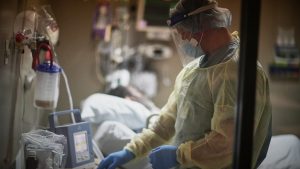Control vs. Spontaneously Initiated Breaths
Control breaths are the breaths delivered according to the set respiratory rate on the ventilator. For example: if the respiratory rate is set at 15bpm, that means that there are 15 breaths that will be delivered in one minute—one every 4 seconds. Even if the patient does not have a drive to breathe, the air will still be delivered every 4 seconds.
We have just outlined that, even in control modes, patients can choose to initiate breaths above the set respiratory rate. This means that, if the patient has their normal physiologic drive to breathe, they could initiate additional breaths as well. But if they do not, the ventilator will always deliver the set respiratory rate at a minimum.

So how does a ventilator “sense” a patient?
We have already established that positive pressure ventilation pushes air into the lungs. Microprocessors are constantly evaluating the flow of air that is leaving the ventilator and being delivered to the patient through the ventilator circuit. Recalling the process of normal physiologic breathing, think about the action of the diaphragm contracting and dropping down in the thorax. We have talked about how this movement creates a negative pressure and air will flow into the lungs. Remember that the patient is intubated and connected to the ventilator through the patient circuit. This negative pressure will pull air from the circuit. The microprocessors of the ventilator are calibrated to the normal flow of air and pressure in the circuit, and even a small change with air moving into the chest is sensed by the ventilator. This is called a trigger because the ventilator senses this change and it “triggers” the delivery of the set breath.
Ventilators can be set by the health care provider to sense changes through either pressure or flow. Both triggers operate in a similar way:
- A pressure trigger is activated when the contracting diaphragm decreases the overall pressure of air in the circuit.
- A flow trigger senses air being pulled from the circuit from the drop in pressure that the diaphragm creates.
Flow triggers are more commonly used on most ventilators in current practice. When the flow hits the threshold of the set flow trigger, a breath is delivered. The amount of flow that the patient needs to pull is negligible before the ventilator senses the patient initiating a breath, and then the ventilator will deliver the set breath based on the mode and settings selected. A normal flow trigger is 2-3 lpm. When you think that ventilators respond in fractions of a second, even a minute change (pull of air toward the patient) triggers the breath.
An experienced provider will be able to see the changes in pressure and flow described above at the beginning of a breath by looking on the ventilator screen at the waveforms that show the delivery of the air. Reading waveforms is outside the scope of the course, but when it comes to patients triggering breaths in control modes, all you need to remember is that it will cause a small negative pull in flows and pressures before the initiation of the breath on spontaneously triggered breaths. Control breaths would not have that small negative scoop before the waveform.
An easy way to see if your patient is triggering any breaths above the mandatory respiratory rate is to compare the total respiratory rate the patient is breathing against what you have set in the settings. If you set 15bpm and you notice the patient is breathing 18bpm in total, it is obvious that the patient is triggering breaths above the set respiratory rate.

